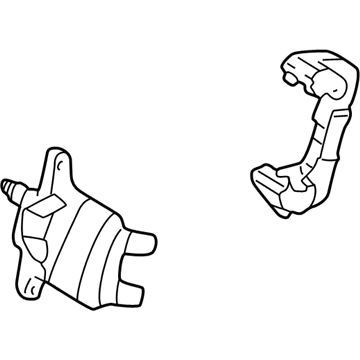×
ToyotaParts- Hello
- Login or Register
- Quick Links
- Live Chat
- Track Order
- Parts Availability
- RMA
- Help Center
- Contact Us
- Shop for
- Toyota Parts
- Scion Parts
My Garage
My Account
Cart
OEM 2003 Toyota MR2 Spyder Brake Caliper
Caliper- Select Vehicle by Model
- Select Vehicle by VIN
Select Vehicle by Model
orMake
Model
Year
Select Vehicle by VIN
For the most accurate results, select vehicle by your VIN (Vehicle Identification Number).
4 Brake Calipers found
2003 Toyota MR2 Spyder Caliper Assembly, Rear Driver Side
Part Number: 47750-17160$205.26 MSRP: $293.07You Save: $87.81 (30%)Ships in 1-3 Business DaysProduct Specifications- Other Name: Cylinder Assembly, Disc; Disc Brake Caliper, Rear Left; Caliper; Cylinder Assembly, Disc Brake, Rear Driver Side; Brake Caliper
- Position: Rear Driver Side
- Part Name Code: 47750A
- Item Weight: 8.20 Pounds
- Condition: New
- Fitment Type: Direct Replacement
- SKU: 47750-17160
- Warranty: This genuine part is guaranteed by Toyota's factory warranty.
2003 Toyota MR2 Spyder Caliper Assembly, Passenger Side
Part Number: 47730-17160$205.26 MSRP: $293.07You Save: $87.81 (30%)Ships in 1-3 Business DaysProduct Specifications- Other Name: Cylinder Assembly, Disc; Disc Brake Caliper, Rear Right; Caliper; Cylinder Assembly, Rear Disc Brake, Passenger Side; Brake Caliper
- Position: Passenger Side
- Part Name Code: 47730B
- Item Weight: 8.40 Pounds
- Condition: New
- Fitment Type: Direct Replacement
- SKU: 47730-17160
- Warranty: This genuine part is guaranteed by Toyota's factory warranty.
2003 Toyota MR2 Spyder Caliper Assembly, Driver Side
Part Number: 47750-17150$189.53 MSRP: $270.61You Save: $81.08 (30%)Ships in 1-3 Business DaysProduct Specifications- Other Name: Cylinder Assembly, Disc; Disc Brake Caliper, Front Left; Caliper; Cylinder Assembly, Disc Brake, Driver Side; Brake Caliper
- Position: Driver Side
- Part Name Code: 47750
- Item Weight: 12.10 Pounds
- Item Dimensions: 10.1 x 7.8 x 5.4 inches
- Condition: New
- Fitment Type: Direct Replacement
- SKU: 47750-17150
- Warranty: This genuine part is guaranteed by Toyota's factory warranty.
2003 Toyota MR2 Spyder Caliper Assembly, Passenger Side
Part Number: 47730-17150$189.53 MSRP: $270.61You Save: $81.08 (30%)Ships in 1-3 Business DaysProduct Specifications- Other Name: Cylinder Assembly, Disc; Disc Brake Caliper, Front Right; Caliper; Cylinder Assembly, Front Disc Brake, Passenger Side; Brake Caliper
- Position: Passenger Side
- Part Name Code: 47730
- Item Weight: 12.00 Pounds
- Item Dimensions: 10.2 x 7.5 x 5.5 inches
- Condition: New
- Fitment Type: Direct Replacement
- SKU: 47730-17150
- Warranty: This genuine part is guaranteed by Toyota's factory warranty.
2003 Toyota MR2 Spyder Brake Caliper
Looking for affordable OEM 2003 Toyota MR2 Spyder Brake Caliper? Explore our comprehensive catalogue of genuine 2003 Toyota MR2 Spyder Brake Caliper. All our parts are covered by the manufacturer's warranty. Plus, our straightforward return policy and speedy delivery service ensure an unparalleled shopping experience. We look forward to your visit!
2003 Toyota MR2 Spyder Brake Caliper Parts Q&A
- Q: How to Service and Repair a Brake Caliper on 2003 Toyota MR2 Spyder?A: You should start brake caliper service and maintenance by extracting the set ring and cylinder boot through screwdriver operation. A piece of cloth should be inserted between the piston and caliper before employing compressed air to evacuate the piston from the cylinder while avoiding sticking fingers ahead of the piston. Screwdriver use enables removal of the piston seal together with the bleeder plug after tightening it to 8.3 Nm (85 kgf-cm, 73 inch lbs.). Pull out both sliding pins from the torque plate as well as the two dust boots before carefully fitting the metallic portion in the torque plate for reassembly. Pad lining thickness measurement needs a ruler to check the standard 11.0 mm (0.433 inch) and minimum 1.0 mm (0.039 inch) specification; replace the pad when thickness falls below minimum or shows severe or uneven wear conditions. Your inspection should include micrometer assessment of disc thickness since the standard stands at 20.0 mm (0.787 inch) and the minimum requirement is 18.0 mm (0.709 inch). Disc replacement must occur in cases where measurements show minimum standards or observe bad scoring or uneven wear. A dial indicator should measure the disc runout at 10 mm (0.39 inch) from the outer edge to check whether its runout stays below 0.05 mm (0.0020 inch); continued runout exceeding the limit requires checking the bearing play and axle hub runout. An on-car brake lathe will grind the disc to adjust its runout condition when both components are normal. The disc runout adjustment becomes necessary by removing all components including knuckle bolts, torque plate and hub nuts before installing the disc in various hub positions. Reinstall the disc by turning it one-quarter rotation from its original position on the hub then torque the hub nuts to 103 Nm (1,050 kgf-cm, 76 ft. lbs.) and measure disc runout while recording position and runout values. The disc installation continues on the other two hub positions through this method. The selection criteria depends on runout measurement results where the minimum value under 0.05 mm (0.0020 inch) means selecting that position unless the recorded value is higher requiring a new disc before reshuffling the measurement procedure. After installing the torque plate secure the mounting bolts using torque of 109 Nm (1,112 kgf-cm, 80 ft. lbs.). During reassembly you should apply lithium soap base glycol grease on specified parts in the reverse order of disassembly.















